How To Catch More Trout, Steelhead, And Salmon, Guaranteed!
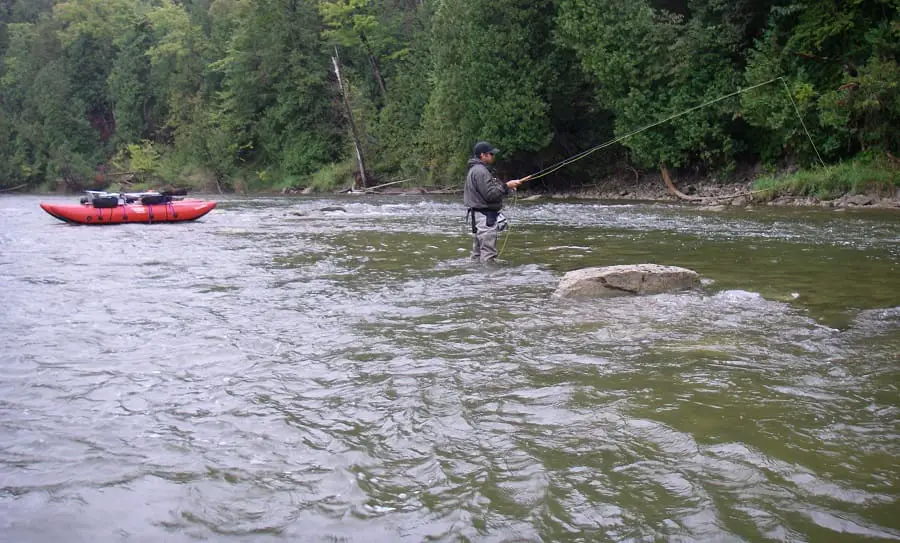
I’ve been fishing for over 36 years, and I’ve been a fishing guide for over 22 years with some years over 300 days of guiding. I’ve even competed in fishing tournaments, but best of all, I’ve had the privilege of fishing with many expert anglers.
One thing that I have learned in all that time is that the top anglers and guides think differently, and they do things that other anglers don’t do. Those things are the reasons they catch ten times more fish than the average guy.
I’m about to reveal their secret!!
I’m also going to tell you now that ANYONE can do it!
I’ve got hundreds of pages with tons of advice and tips from myself and other guides, but this is likely the most important page you will find if you really want to learn the secret to catching more trout, steelhead, or salmon.
After guiding thousands of anglers, I’ve realized that 90% are missing out on potential fish when they don’t need to.
I discuss all the things that I have witnessed over the years that prevent anglers from catching more trout, steelhead, and salmon.
Guides Advice:
I’ve been asked this over a hundred times by clients; they ask, ” What’s the one thing that you do that makes you so good at catching fish?”
My answer, ” it’s not one thing that I do that makes me good, it’s a whole bunch of little things I do added up that make catching fish often easy for me”.
So what’s the most important thing to catching a trout or steelhead, all of it put together.
How To Catch More Trout And Steelhead?
Most guys think it’s the best bait or the perfect presentation that will catch them more fish, but they’re wrong. To catch more trout and steelhead, you need to realize that it’s many little things all working perfectly together that will result in more fish, and if one of those things is wrong, it could mean no fish.
I can not guarantee that you will catch more trout by simply telling you what my best trout bait is, or what my best fly is for trout or steelhead.
I also can’t guarantee that you will catch more trout and steelhead just by telling you what my secret presentation is that I use to outfish most guys 10 to 1.
Even if I tell you what methods I use under different river situations or if I show you my most effective leader setups, it still won’t matter. It still will not guarantee you more trout or steelhead. So, what will guarantee more trout and steelhead?
This is advice that nobody is talking about, and it is way better advice than all the other stuff I just mentioned.
In fact, I know that it will make all that other stuff ten times more effective and that it will guarantee that you will catch more trout and steelhead.
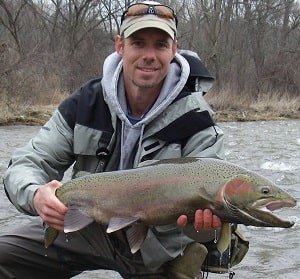
I wish I knew this when I started.
I was like most anglers. I focused on lots of little things as I learned to fish. One day, it was to learn what the best bait is, what the best float is, or what the best line is. The next day, I was learning something else.
It was like a puzzle, and I was finding all these little pieces over the years and then trying each of them to experiment to see what actually worked and what didn’t.
A lot of these little things do matter, like the best bait, the presentation, the best hook, etc. But, honestly, none of it means anything if you don’t use it all together and all at once!
This is like the glue that holds everything else together, and it will allow you to put all the pieces you’ve learned together so that you can start catching more trout, steelhead, or salmon.
These are the most important tips I can give anyone who wants to go from catching 1 or 2 trout or steelhead a day, to 10 or more. . . . .
Fish Right For More Trout, Steelhead, And Salmon
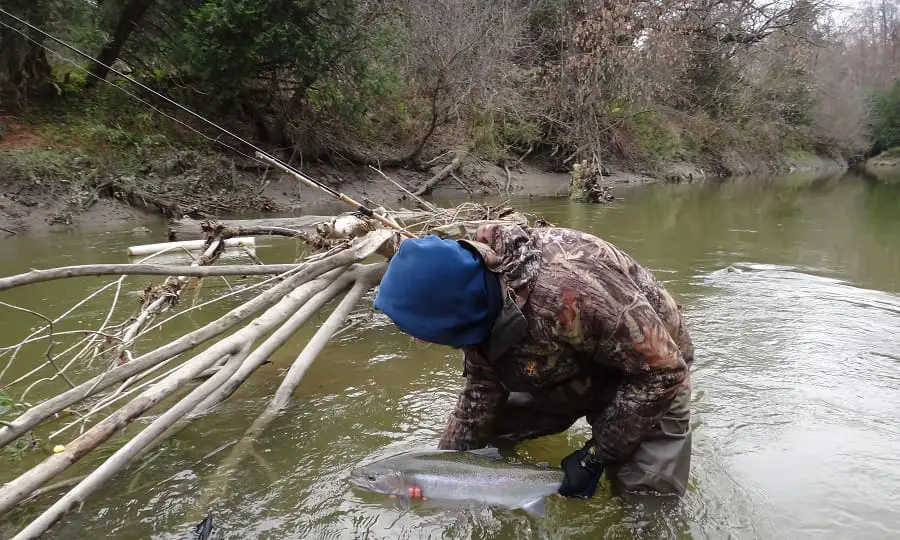
After guiding thousands of anglers, even ones that have been fishing longer than I have, and even other guides, I have determined that most guys just don’t fish very well, but worse is that that they don’t even realize it.
And because of that, they miss a lot of fish that they could or should be catching.
Sure, they catch some fish, sometimes, and they think that’s probably good fishing, but they are simply missing a lot of fish that they could easily be catching, and they don’t even know it.
This is what I mean. Have you ever gone out and caught ten steelhead and thought that was a great day? But was it really?
How do you know that there isn’t something missing or something you could have done differently, that would have caught you twenty steelhead instead of 10? You don’t know!!
The thing is that you don’t know what you don’t know!!
In fact, it’s almost never that I see the information online that is complete.
There’s always something missing in articles or videos, and then we are left to try and fill in the blanks, which is why we keep searching for more information.
Fishing the right way is more than just using the right method, getting a great presentation, having the right bait on the line, or knowing how to read the water.
Most Trout And Steelhead Anglers Could Be Catching More Fish
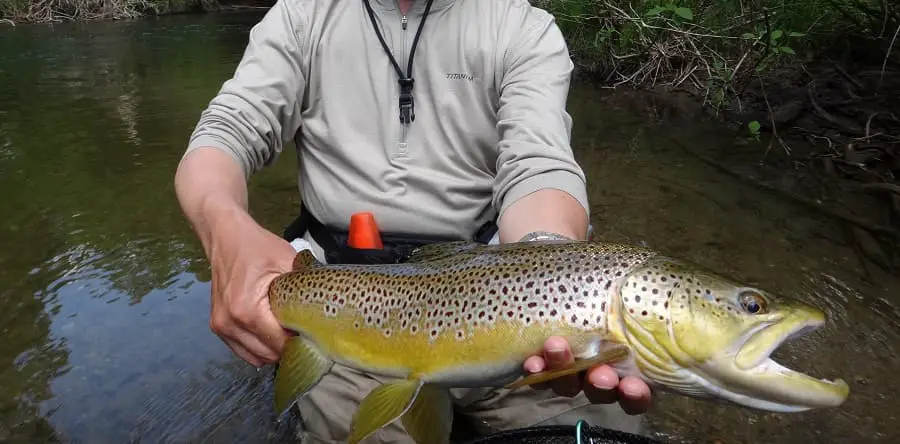
Based on what I know and have seen, eight out of ten anglers simply miss fish that could easily be caught.
Most anglers just grab their rod and reel, grab some bait, and then they go cast all day in a river somewhere, and they wait and hope that they catch some fish. They rely on luck and some basic knowledge.
But I know that if you replace luck with real skill and knowledge, you will catch ten times more trout and steelhead! The experts do!!
The Fishing Process – Catch More Trout And Steelhead

If you want to learn how to catch more trout and steelhead, you need to understand that fishing for trout and steelhead is a process, and knowing what the process is from start to finish is the key to catching more trout and steelhead.
You simply need to understand that the fishing process that I am talking about is like a chain, and one weak link in that chain makes the entire chain weak, and two weak links in the fishing process makes it even worse.
Doing everything right all at once is the real difference between one guy catching ten fish and another guy catching none.
The best bait or the best presentation are only small links in that process, and they are practically useless if you have other weak links in your fishing process.
The problem is that most anglers don’t know what those weak links are, or they don’t know that they even have a weak link in their fishing process, and the unfortunate truth is that is what is preventing them from catching more fish every time they go fishing.
There is a saying another saying in the fishing industry, “10 percent of anglers, catch 90% of the fish”. I believe this is 100% true because I see it proven over and over again.
I’ve watched two of my clients fish poorly all day and only catch a few steelheads and then talk to my buddies that were just upriver fishing and some fishing downriver from us, and they hooked 75 steelheads.
These two clients had all the right gear, the leader setup was perfect, they were put in the best spots and told by me where the fish were, and they even used the best bait, and they still only caught three steelhead between the two of them when other guys were catching more than 20 each. Why?
Something in their process was wrong, and I knew exactly what it was, but when your clients don’t listen to you, there’s not much you can do about it.
Be Open Minded, Don’t Be Stubborn
You see, I know from guiding thousands of anglers that some guys are strong-headed, or call it stubborn, or they are stuck in a rut because they learned a certain way, and in their heads, that’s just how it’s supposed to be done. Or they simply don’t understand how important certain things are to fishing.
I remember a day guiding, I was trying to drill into a client’s head how to present his fly. His fly was constantly too deep, and his fly was also moving too fast. I knew the trout were there and that they were feeding because I could see frequent flashes of silver and white below the water. I also knew that spot like the back of my hand.
I was relentless, telling him on each drift what changes he needed to make to his drift.
He was getting frustrated, and after an hour of no fish, he finally got mad enough to say to me, “It’s not going to make a difference because they just aren’t bitting, lets go somewhere else.”
I grabbed the rod out of his hand and told him to take a break and just watch. I made six casts with the same fly that he was using for the last 20 minutes, and I caught five little trout and one sucker in those six casts. He caught none in an hour. I then told him, ” it does matter, it matters a lot actually.”
I then said, “Do you want to keep fishing, or do you want to learn how I just caught six fish in 6 casts.” Guess what his answer was?
I have grabbed the rod out of hundreds of clients’ hands after they could not catch a single fish, made one or two casts, and caught a fish or two. I do this so they see what could happen if they just do it right.
Missing some of the finer details of the fishing process and having even one weak link will mean fewer fish or no fish! This is something that I guarantee because I have seen it happen hundreds of times.
The fishing process includes everything from the river, the spot, the method you use, your approach, your angles, the speed of the bait, where you present your bait in the water column, the bait itself, the setup, your presentation, and more…
Even where you stand, or how you enter a spot can make a huge difference.
I Can Guaranty You More Fish
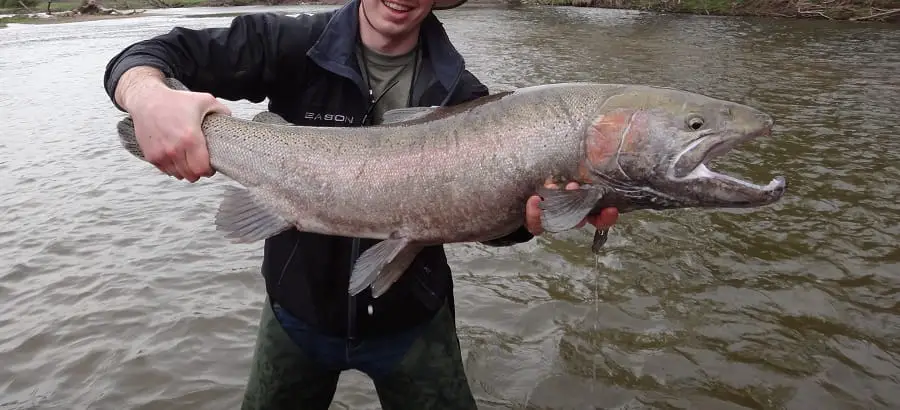
How can I be so bold that I can guarantee you more fish, and even bigger fish?
Honestly, I can’t really guarantee you more fish because maybe there’s just no fish in the river that you are fishing, but what I can guarantee is that if you eliminate the weak links in your fishing process and you make sure that all the parts of the fishing process are there, you will catch more fish if there are fish there to be caught!
You will also increase your chances of catching bigger trout. More fish and bigger fish, isn’t that what we all want?
You see, small fish are easy to catch, so even with weak links in your process you’re still likely to catch some fish. But big fish, especially big wild fish, are much harder to catch. A weak link is almost guaranteed to stop you from catching the big ones.
I spent the morning guiding and had a few hours to kill. Two young guides walked past me on the trail as I made my way down to the river. They were bragging about the one big 20-inch brown trout they caught that morning. Within 3 hours, I hooked 11 brown trout over 20 inches and landed 9 of them, with one being 26 inches.
I texted my guide buddy to see how his day was going thinking that everyone was having a great day. He said he was in the local fly shop, and that he only heard of a couple of big browns caught that morning, but other than that, it was a slow morning for most guys.
He and the guys in the shop, which included those two guides I saw, were in disbelief when I told him I’d hooked 11 over 20 inches until I sent him the pictures of 9 big browns.
You see, even river guides can struggle to catch big fish because they sometimes get stuck in a rut and forget to think outside the box!
I was using a unique method of fishing known as Euro Nymphing, and while all the other guides were dry fly fishing or nymphing with indicators to pressure fish, I wasn’t!
Their weak link that day was not adapting to the conditions or to what the trout were telling them.
The reason I can guarantee you more fish is that I know that even a single weak link in your fishing process will mean fewer fish, and it doesn’t matter if you are a so-called guide or not.
I know this because I have watched thousands of anglers fish wrong or poorly, and after I have fixed their fishing process and identified all their weak links, they always end up catching more fish for years afterward.
Hundreds, if not thousands of anglers have told me how much better they fish once they have mastered their fishing process and eliminated the things they were doing wrong.
Eliminating Weak Links Is Critical
Eliminating weak links can have significant positive effects on your fishing.
It’s sometimes so significant that some anglers will even tell me that before a guided trip with me, they would catch an average of 5 or 6 trout in a day, and maybe they would get lucky and catch 1 or 2 big ones a year, but . . .
After their guided trip with me, they are now averaging 25 to 30 trout a day, and they are hooking into big trout almost every single day on the water. That’s how drastic a change it can be once you master the entire fishing process for trout and you eliminate the weak links.
The weak link problem is so obvious for most anglers that I’ve been able to watch two anglers fish side by side with identical setups and the same bait, and one angler catches ten trout or steelhead while the other angler catches none. I have seen this happen hundreds of times.
What’s crazy is they are fishing with the same gear, the same setup, and the same spot.
I often start the day off using a different bait on each client’s hook to help me figure out which bait the fish want.
On days when one guy catches 10 fish, and the other guy has caught none, I will sometimes experiment by taking the bait that is catching all the fish off of the guy’s line that is catching all the fish, and I will give it to the guy that’s not catching any fish. I would then take the bait that was not catching any fish, and I would give it to the guy who was catching all the fish.
It’s amazing, but the results are always the same.
The bait that was catching all the fish stopped catching fish, and the bait that wasn’t working is now catching all the fish. This clearly shows that the bait is often not the problem.
The reason why one angler is not catching any fish is a weak link or two in his fishing process; something he is doing is not right, and if both of them have the exact same setup, it’s likely the weak link is in his presentation somewhere.
For many guides, this is often the biggest challenge, finding out what your client is or isn’t doing that is causing them to not catch fish. This is how I discovered the fishing process and why it’s critical to remove the weak links.
The Bait
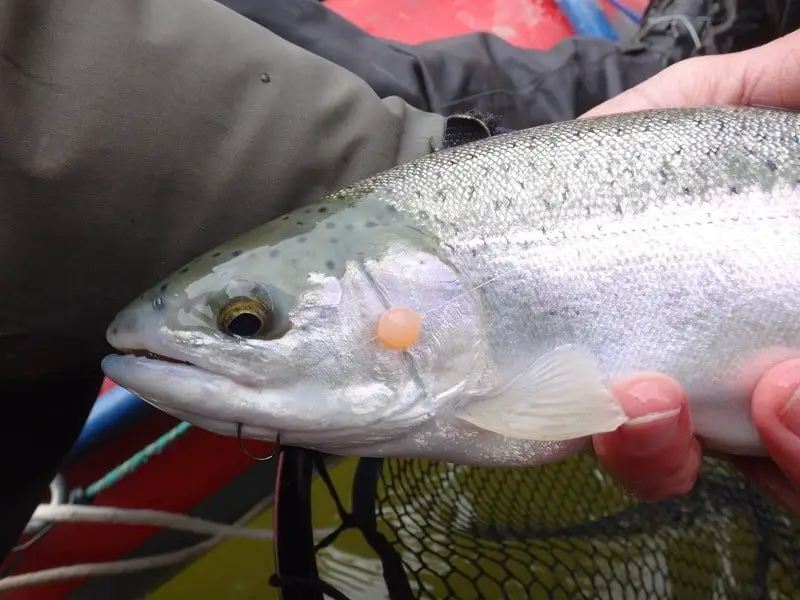
Most anglers think about the bait first and foremost, but the bait is far from being the most important thing in trout and steelhead fishing.
There is a saying “A bad bait fished good, is better than a good bait fished bad”. This is also 100% true.
I bet you that I have run into over 100 anglers on the river who asked me what bait I am using after I told them I landed ten steelhead, and they landed two.
Even other guides have asked me that same question when I tell them how many fish we are catching. I often tell them, “That’s the wrong question”!
In fact, if it’s one of my guides who asks that question, I give them shit for it because I know that 90% of the time, the bait is not the reason for catching so many fish and they should know better.
The problem is, that’s the first question that comes to everyone’s mind, and it’s a hard thing to break. It’s almost like we’ve been brainwashed to think the bait is the key to more fish, but it rarely is.
Guys ask that question because they think that if I caught five more fish than they did, the bait is the reason for catching more fish. Sometimes it can be that I was using a more effective bait, but most of the time, it’s not.
When I see an angler catch all the fish, I don’t just look at the bait he is using. Instead, I look at how he is using the bait, and everything that he is doing that makes that bait work so good. I want to see his fishing process. To me, that is far more important than the bait.
I know from experience that it doesn’t matter how good your bait is if you present it to the fish wrong, or if your hook is too big, or if your leader is so thick that every trout in the pool sees it, or if you simply drag or bounce your bait past the fish. A single weak link could make even a great bait useless.
Eliminate Common Mistakes
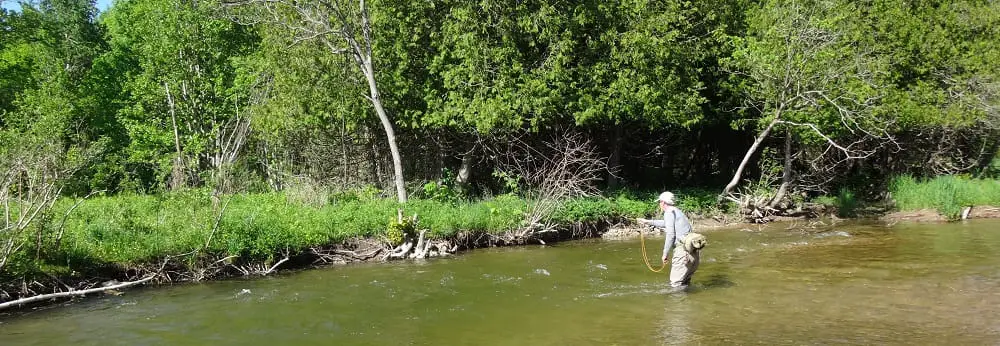
I see it all the time, most anglers make the exact same mistakes, and many of them are so obvious and are very easy to eliminate if you know what they are.
I will discuss these mistakes in many of my articles on this website so that you will know what to look for.
Some mistakes are so obvious to me as a guide of over 20 years that I can see them from a mile away.
Last year I was standing beside a client and I saw a guy about 500 feet or more up the river working his way toward us and he fishing each spot as he went.
I stopped my client from fishing and said, “Here is a very important lesson for you, let’s watch this guy for a little while, and I am going to point out all the mistakes that guy is making because just watching him for 15 seconds and I already know that he is not going to catch any trout, at least not any big ones”.
I also said, “his mistakes are very common and very easy to fix.” To me, they are obvious, but anglers do them all the time.
I could tell from over 500 feet away, just by the amount of splash coming off that guy’s legs as he walked through the river as approached each spot that he wasn’t going to catch any big trout. He was simply far too noisy, he was also approaching the trout from the side or from upriver.
Doing this means those big trout will be spooked and will be lock-jaw until they feel the danger has passed. So before this guy even makes the first cast in each spot he already has almost no chance of catching any big trout.
Ten minutes later, the guy came walking past us and had caught no trout in that time. When I asked him how the fishing was he said only a couple small fish all morning, and off he went.
The crazy thing is that 30 minutes later we went and fishing all the spots that guy fished and my client hooked about 25 trout in that same stretch including a 17 inch brown trout and a 21-inch brown trout.
That angler missed so many trout simply because he was making multiple mistakes as he fished. Even if I stopped him and gave him the same fly that we were catching all our trout on, he still wouldn’t have caught many trout.
I asked earlier, how do you know if you’re catching as many as you should be? To this guy, he probably just assumed the fishing was slow. Or, as many anglers do after they catch no big fish in a spot, they think there are no fish there.
I always assume there are multiple fish in every spot I fish and if I don’t catch them I assume it’s me and something I’m missing that’s the problem.
I have fished great spots with clients and caught none. After fishing the spot and to teach these guys a lesson, I will say, “Do you want to see how many steelhead you just missed?”
I will then float my drift boat over the middle of the pool and have them look for fish. Most guys are blown away when they see 5 to 10 steelhead, salmon, or big trout scatter as the boat goes by. This is an eye-opening experience for most anglers and a great lesson.
I have done this a thousand times, which is why I always assume there are lots of fish in every spot. Just because you don’t catch a fish in a spot doesn’t mean they aren’t there, and it doesn’t mean they couldn’t be caught, it just means you didn’t do what was required to catch them.
Presentation Is Key, Right?
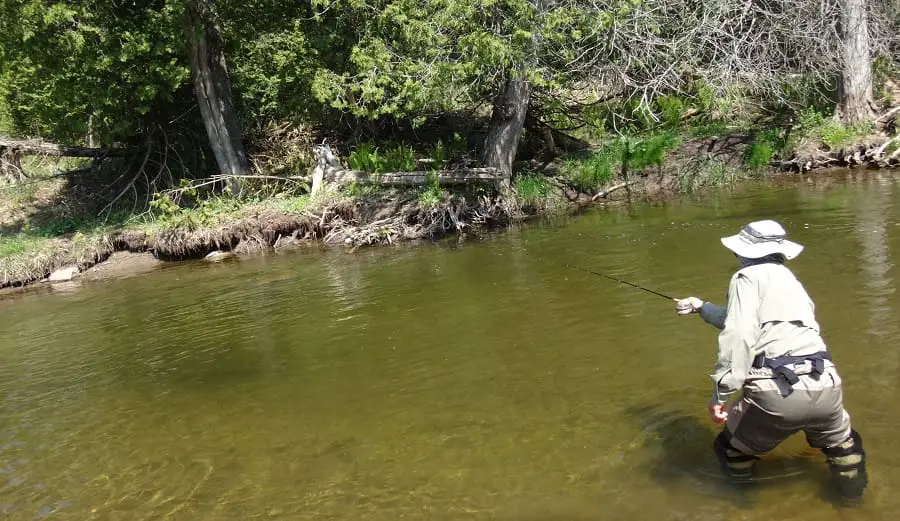
I’m sure you have heard this before from a lot of other guys, “presentation is the key to catching more fish.” But guess what, they are wrong! Or, should I say partially wrong?
You should know the truth, and that truth is that presentation is NOT the key to catching more trout and steelhead.
Don’t get me wrong, presentation is a HUGE part of catching more trout, steelhead, and salmon, and it might the most important thing, and it’s definitely something I work hard on teaching my clients, but the presentation is not everything.
And, if you have weak links in your fishing process, the presentation is useless. Thinking that presentation is the key will give you false confidence. Presentation is simply another link in your fishing process chain, and it’s only as good as your weakest link.
If the angler in the above picture approached the pool he is fishing from the top of the pool, he would have likely spooked most of the wild brown trout in this river. Once those trout are spooked, it doesn’t matter how good his presentation is.
So if you think presentation is the key and you ignore the other weak links in your fishing process chain, you will still struggle to catch trout, steelhead, and salmon, and you will leave fish in the pool that could have been caught.
There are many other factors that will make your perfect presentation nearly useless.
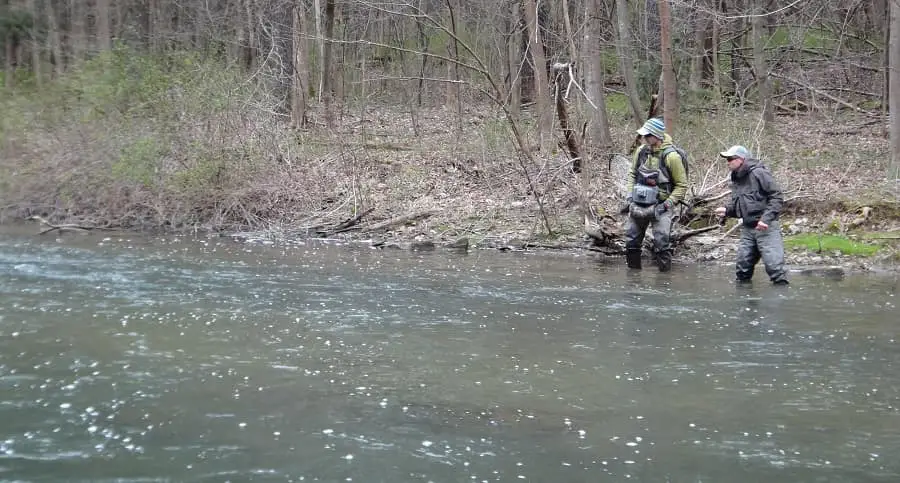
I invited one of my buddies out to fish for steelhead with me on my day off of guiding. He’s a really good Centerpin angler and his presentation and skills are usually flawless.
I guided the day before for steelhead on the same river, and so I walked him straight into a spot that was loaded full of steelhead the day before.
Being the nice guy that I am, I said, “you go first, you should get one on your first drift.”
He made a drift and caught nothing, so I said, “Try again.” He made a second drift, and then a third, and then a fourth drift, and still no fish.
To me, that was a surprise because his presentation looked flawless and there was a ton of fresh run steelhead in the river, so I knew something just wasn’t right.
I knew there must be a weak link in something he was doing.
As a guide, I sometimes spend half the day in my head just trying to think of how to get more fish to bite. Even when the trout or steelhead are biting well, I’m often still trying to figure out how to get even more of them to bite, it’s just what I do.
So now that my friend wasn’t catching any fish when I was sure he should be, this was no different than guiding a client for me, and I had to figure this out. I hate when the fish beat me.
I first asked him what spawn he was using and how old it was. I then gave him one of my spawn bags because my spawn bags were hot the day before. He made a few drifts with that new bag, and still no fish would bite, Weird.
Then I asked him what hook he was using. He had this big extra-strong hook on that he used the last time he fished for salmon on the Niagara River. So, I said, “Cut that off and tie on this hook,” and I handed him the same size and type of hook that I caught all the fish on the day before. Then I gave him a new spawn bag and watched him make a few more drifts, but still no fish!
I then asked him, “What pound leader do you have on the bottom at the hook,” he replied, “6 pounds.” Most anglers think 6-pound leader for steelhead is OK, especially in the green water that we were fishing that day.
In fact, some anglers would even think 6-pound leader is too light for steelhead and would recommend going up to 8 pounds for steelhead, but this can be a huge mistake that a lot of anglers make, and you will see why.
Even though it says 6 pounds on the label, I knew that not all leaders brands rate their leaders accurately, so I said, “What brand of leader”, he replied, “Drennan.” That’s a problem for me!
I know Drennan Leader, I use Drennan leader.
Drennan is a very popular leader brand in my area, and it’s a brand that I use and recommend all the time, but I also know that 6-pound Drennan is not rated properly and that it’s the about the equivalent to many other brands 12-pound test leader material.
12 pounds is just too heavy for most Great Lakes steelhead and trout fishing, in my opinion.
After he told me 6 pounds Drennan, my reply was, “That sh!t is so thick and strong I could probably tow a car with it”.
I gave him some 4-pound Drennan, with the right hook, and the right spawn bag, and he proceeded to then hook 9 steelhead in 9 drifts in a row. Wow, 9 in a row!
That was actually close to what I was expecting when we first started fishing there, which is why I was so surprised when he wasn’t catching any fish.
His weak link could have been any of those things that I changed, like his spawn bag, or his hook, but the conclusion was that even though his presentation was perfect, his leader was simply too thick and the fish were seeing it and ignoring his bait.
So, is presentation the key to catching more fish? Nope, not really?
Although my buddy had a great presentation and a great bait with tons of steelhead in that spot, the wrong leader made it impossible for him to catch any steelhead there, that was his weak link that day, and he and I learned a valuable lesson that day.
Determining Your Weak Links
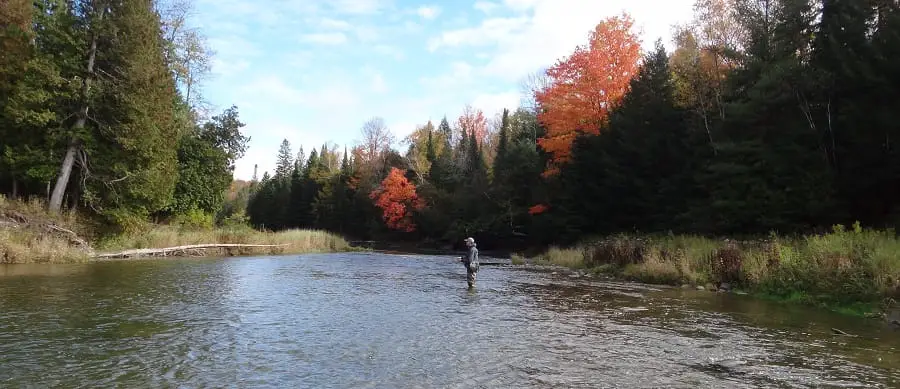
I discuss the best baits, hooks, gear, presentation, leader setup, and I even explain the best brands and diameters of leaders and what the right sizes of leaders for trout and steelhead are throughout the pages on this website. But as you can see, none of that really matters if even one of them is wrong.
Unfortunately, some of these weak links are very subtle, and they might be hard to determine for the average angler, speed control is one of those things that most angler miss.
Control Your Bait Speed: A Critical Link
Speed control means presenting your bait at the same speed the natural food is moving at. I discuss speed control on a couple of pages, and I believe speed control is a critical part of the fishing process. In fact, I’m convinced it’s possibly the most important thing.
Remember the story I just told you about my two clients catching only a few fish when 3 of my buddies caught 75. Also, in that story about the two anglers fishing with the same bait and same gear in the same spot, and the one guy caught 10, and the other guy caught none, a lack of speed control is a large part of the reason why the guys were not catching fish when others were.
I can often watch a guy drift his bait down the river and know that he’s not going to catch a fish on that drift simply by the angle of his float or the speed at which his float is moving.
I can then see him do it right and get a great drift, and I’ll say, “That drift will catch you a fish,” and his float goes down two seconds later with fish on!
Some things will be easy for you to see and eliminate, and others will take time to figure out. Speed control is not easy for most anglers because they see how fast the surface current moves and they believe that is the right speed, it’s NOT!
Want proof?
There is a reason that the newest fly fishing method called Euro nymphing is so much more effective than all other nymphing methods from the past, and why the best anglers in the world use it religiously.
If this new method weren’t so good, the top guys would not use it.
So why do they use it, and why do they catch so many more fish than other methods?
It’s because of the improved ability to control the speed of their flies, and it’s because you can match the bottom current better. Why?
It’s because they use super thin lines that don’t get pushed too fast by the surface current. It’s also because they don’t have an indicator or float that gets pulled or dragged too fast by the surface current.
It’s because the current 6 feet down is not the same speed as the surface current, and it’s because the fish feeding in the bottom current are often seeing debris and food moving at half the speed, or even 80% slower than the surface current.
Without anything pulling or dragging your fly at the speed of the current, the fly will be the only thing pushing it, and it will move at the speed of the current where the fly is. This means your fly will more effectively match the current speed and look more natural to the fish. It will also be a slower target.
So if your bait is moving 75% faster than everything else that the fish are seeing, simply because your float is going the same speed as the current, your bait looks odd, it looks unnatural, and it might even look dangerous to the fish.
“I’ve said this many times before, “fish are dumb as a brick, but they are instinctually cautious, which means anything out of the ordinary in their environment they will avoid, or might even spook them.”
That includes your bait!!
Especially so if all the debris and food they feed on daily, (I’m taking thousands of stuff drifting by them daily), is all moving at 2 miles per hour, and your bait or fly goes zipping by them at 6 miles per hour, guess what, it looks super unnatural, and they won’t eat it, at least the smarter big ones won’t eat it, the little ones are dumber than a brick and they eat anything sometimes.
so, if you are always only catching little ones… well… fish smarter than a brick, fish better, and slow down your fly!!!
Conclusion
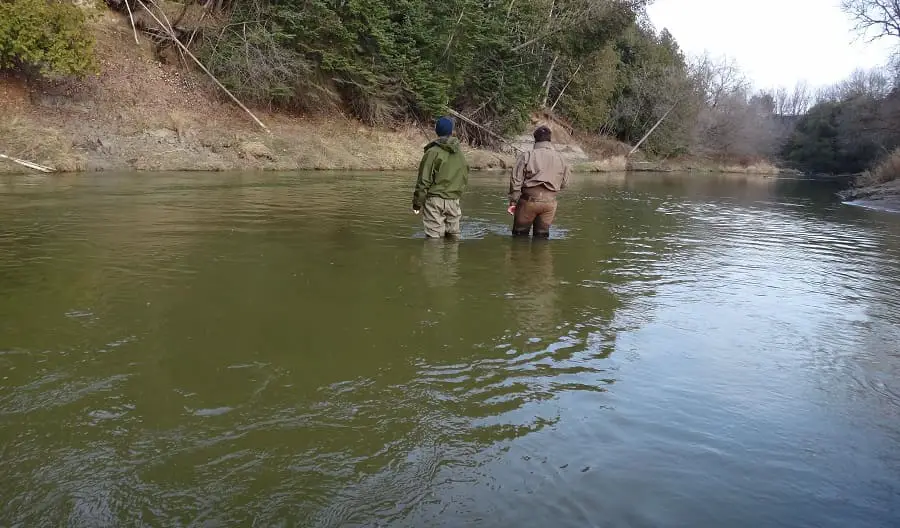
Let me break it down:
- Use the right gear.
- Use the right setup. This includes the right size line and the right hooks.
- Learn how to read the water to find and concentrate on areas with more fish.
- Understand the fish. Where they eat, where they rest, where they hold, spawn, etc.
- Don’t waste time with less effective baits. Learn what works best, and use high-percentage baits and flies.
- Approach the fish slowly and quietly, and don’t spook them before you even make a cast. Don’t be in a rush!
- Use an excellent presentation, and continue to get better. Strive to make every drift, cast, and retrieve perfect.
- Control your speed, control your speed, control your speed!
- If you cast lures, learn how to work them, where they should be in the water column, and how fast to retrieve them.
- Get your bait at the right speed and depth.
- If something is not working, figure it out. Sometimes, the fish don’t bite, but most of the time, you can probably do something to improve your odds.
- Think outside of the box. If you fish the same way all the time but rarely catch fish, it’s probably not the fish!
- FOCUS ON GETTING ALL THE LITTLE THINGS RIGHT, AND ELIMINATE YOUR WEAK LINKS.
- Learn from experts who have already figured it out.
Learn From The Right People
Many anglers learn from other anglers that don’t really know what they are doing. What’s that saying, “The blind leading the blind.”
There is lots of proof of this… Like why do I keep seeing corn on the bank or on anglers’ hooks? It’s because there are still some high-ranking websites out there that say corn is good for trout, the website was probably written by a clueless angler that saw another angler using it.
Or maybe guys still use corn as bait because some dude with no skill filmed himself catching trout in a stocked pond once. There is a ton of bad tips and advice online.
Ever seen a good river guide using corn as bait? No, that’s because good guides and experienced anglers know better.
I get on the fishing forums all the time and see so much really bad advice coming from guys with good intentions, but who are just wrong. They are guys that are still trying to figure it out for themselves.
This website was started because I was tired of guys coming out with all kinds of bad habits and bad methods and doing dumb stuff, or using really bad gear and then wondering why they can’t catch any fish… I knew guys needed better sources of information so I started putting what I teach on the river in words on a website.
The only good thing about all the bad advice online is those bad anglers are good for business if you are a guide. If everyone could catch fish like I can, why would they need a guide, right?
I make a living off of bad anglers, but it’s not my fault they are bad, and I’m happy to teach them.
This website provides anglers with information from experts and guides that have figured out what actually works, and what doesn’t work. And you get it free…..
This website is all about helping anglers understand the fishing process and the importance of getting everything right so that there are no weak links.
Now that you know that you understand the fishing process, you can start working and improving on each thing and eliminating the issues that are holding you back from catching more trout and steelhead.
Doing this will be the difference between fishing a spot with ten hungry trout and only catching 1 or 2 of them because you have a weak link in your process, to going into that pool and catching all 10 of those hungry trout.
I hope to have my YouTube page up soon, so be sure to check us out there. I also hope to write a list article of all the pieces of the fishing process. Till then, thanks for reading.
Tight Lines
Graham

thanks for the info graham keep making these for new anglers like me
how do you eliminate spooking the fish
Hi Nate,
The simple answer is to move slowly, move quietly, and stay behind the fish. Most fish face upriver. I have a saying, it’s better to take 5 minutes to tiptoe 5 feet out into a pool so you can catch a big trout right away than it is to stomp into the pool like a heard of elephants and then need to wait 45 minutes for all the spooked trout to start feeding again.
I often tell my clients to think of a trout in a pool like a rabbit or a deer in an open field. If you wanted to get as close to a feeding rabbit or deer how would you do it? The second you make any noise that rabbit or deer is going to freeze and stop eating, or, they are going to run. A wild trout is no different, they will freeze when they think something is wrong and they will dart away when the threat is too great.
how would you approach the stream without spooking them
Hi Joshua, See Nate’s question below for my reply.
Ok so how should your float point? And I also use 6 to 8 lb fluorocarbon cigar salmon steelhead leader line should I drop to 4 lb.
Hi Joseph,
To understand float angles and speeds check out my page Controlling Your Speed For More Fish When Float Fishing
The leader size that you use depends on the size of the fish and other environmental factors. Sounds like you need to read my page on float fishing
Good luck
Graham
You never mention braided – floating lines for float fishing.
Why?
Also regarding “shot lines” – if the majority of water is maybe 2 -3 feet deep – I dont see how I can effectively use one along with a approximately 18″ leader without constantly dragging my jig. Jig to bobber distance – maybe 3′ – or constantly snagging up – 1/16oz jig.
Hi David, I personally do not use braided lines for 2 main reasons, however, I am not against braided lines if you know how to fix these two issues and braided lines can work quite well. There are advantages and disadvantages to braided lines. The primary advantage of braided lines when float fishing is that they are usually light and strong for their diameter. Light lines do not sag and they float which is great for float fishing presentation. Braided line also has near zero stretch which is a big advantage when setting the hook on a fish that is 200 feet down the river.
The disadvantage for me as a guide is that because the braided line has no stretch, guys will set so hard that they break fish off on the hookset. Until you know how to dumb down your hookset this is often a problem for new anglers to float fishing. The other disadvantage to braided line is that it can freeze and become problematic in below-freezing temperatures and as a guide I spend many days on the water in below freezing temps.
Another big issue for both Centrepin and spin guys is that braided line can expand and shrink after it gets wet and if you do not use a backing of mono first or you secure it with tape where you tie it on the spool the entire mass of braided line can spin around the spool preventing you from reeling in. I have seen this a few times so make sure you look up how to put braided line on a reel before you try a braided line.
As far as the split shot goes, I just slide my float caps over the swivel and put my float on the shot line if I need to fish shallower water of fewer than 3 feet deep. You can also just make your shot line shorter. My shot line is designed for 3 feet or deeper water because, to be honest with you, in water under 2.5 feet deep I switch to my advanced bottom bouncing method. That method would be better with your jigs.
I have updated this page with more information on mainlines for float fishing. Float Fishing For Trout – An Expert Guides Best Tips
Incredible blog, Graham. Your expansive knowledge is well seen by the many knowledgable articles you put out for the community. Thank you for this wealth of good info.
Im patiently waiting for your youtube channel, amazing website anyway
lol… I’m a one-man show at this point.. guiding, teaching, writing, and soon videos. But, you should start to see videos in spring 2023..
Graham
Grahm you talk about float fishing and the difference in the top speed and bottom speed I find this very interesting as I never new this. my question is what’s the best way to slow the bait down when float fishing in the river current.
Hi Jeff,
Controlling the speed of the bait is very important in my opinion. I explain in detail in my article Controlling Your Speed For More Fish When Float Fishing.
Good Luck,
Graham